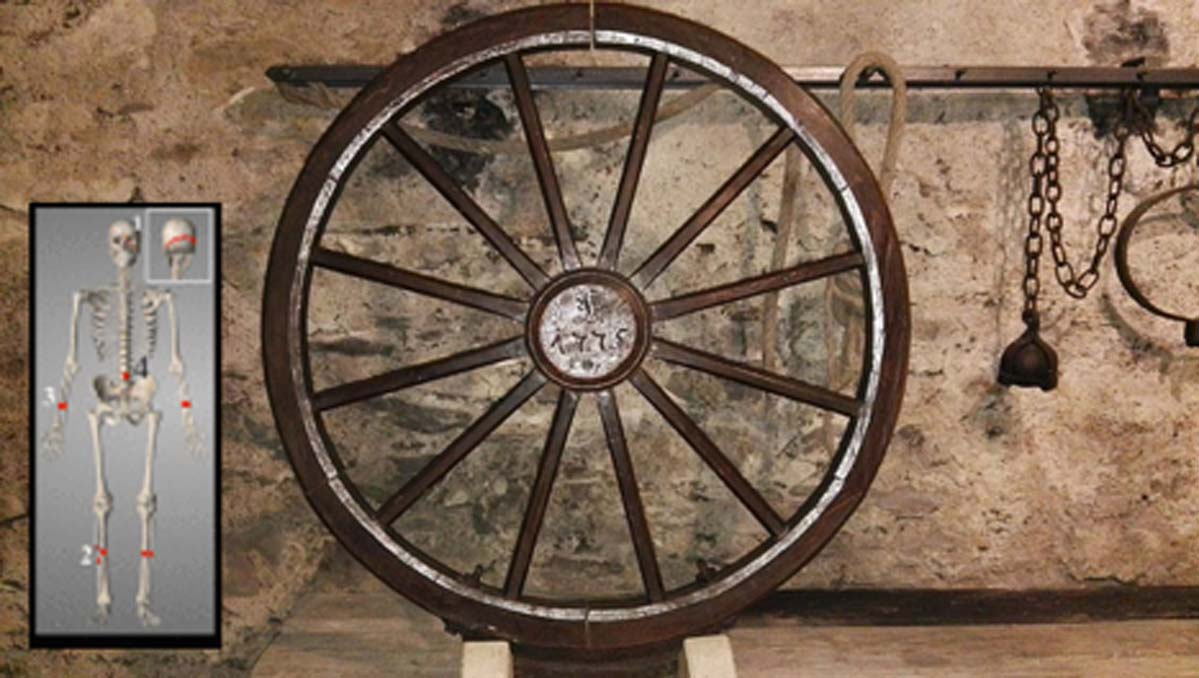Deformed Medieval Man Found Broken By the Wheel of Torture
Archaeologists in Milan have uncovered the shattered remains of a young man believed to have been broken on a wheel of torture.
In medieval Italy different methods of torture were assigned depending on the victim's crime, gender, and social status. Skilled torturers and executioners applied unspeakable methods, devices, and instruments to prolong life as long as possible while inflicting agonizing pain, and this recent discovery in Milan must be among the most horrific cases of torture ever discovered.
A new research article titled First signs of torture in Italy: A probable case of execution by the wheel on a skeleton from 13th century Milano, was published in the Journal of Archaeological Science and detailed the findings of a team of researchers from Università degli Studi di Milano. The researchers examined the remains of 56 individuals dating from the Roman Empire to the 16 th century found beneath San Ambrogio Square in the Italian city of Milan, but a particular individual found with ‘two buckles’ on each side of his body became the focus of their research.
- The Iron Maiden: This Medieval Torture Device Was Used as Recently as 2003!
- Saint Paul’s Column: Ancient Pillar Where Paul the Apostle Was Scourged with Hundreds of Lashes
- Brazen Bull: Gruesome Ancient Greek Torture Device Turned Screams into ‘Music’

Skeletal remains of another man tortured and executed by a wheel of torture. (Wdwdbot / CC BY-SA 3.0)
Successful Torture, Failed Decapitation
The shattered man was aged between 17 and 20 years old when he died and radiochemical tests determined that he lived between the years 1290 and 1430 AD. It was first thought that he had been killed in battle but the scientists soon observed that no other bodies had similar injuries and that his wounds had very specific distribution patterns, for example, his long bones in his forearms and legs had been shattered ‘perpendicularly’.
Furthermore, the researchers reported that his injuries were “very systematic” and were found in the same places on both sides of his body, including blunt force injuries to his face, a stab wound in the vertebrae, and a deep skull fracture which might have been caused during a crude attempt to decapitate him.
The Medieval Torture Resulted in Bucked Body Parts
The researchers analysis of historical reports in northern Italy suggested the man had been subjected to a brutal manner of execution called ‘wheel torture’, which saw its victims being tied to a wooden wagon wheel before a torturer/executioner fractured their bones with a blunt weapon. This man’s smashed limbs had been threaded through the spokes of a wheel and he had been raised on a pole to suffer, before being lowered, stabbed in the body and ‘almost’ decapitated.

The torturer fractured the man’s bones with a blunt weapon. (Phildij / Public Domain)
Archaeologists have only ever discovered a handful of other bodies where people had been ‘broken on the wheel’ as this specific type of punishment was reserved for serious crimes like spreading the Black Death. It is thought that the two buckles found on each side of the body, which began the investigation, might have been used to bind a shroud to keep his broken body parts together.
Smash ‘It’ To Death – The Torture of the Different
While this man might have committed a crime, the researchers have reason to believe that this could have been a case of mass-hysteria sparked over a perceived social ‘freak’. In what was a highly-materialistic society this young man was 4.3 inches (11 centimeters) shorter than the average person for his age and his teeth were buckled which would have given him an unusual smile. According to the researchers, it might have been these physical differences that led to the young man being killed.
Considered as being visually unusual in comparison to his contemporaries, the researchers think he might have been sacrificed for being a ‘freak’ or a ‘plague spreader’ by an angry crowd. If this really was the case then this example of extreme violence, according to the researchers, might represent a tragic historical event of discrimination.
Better Off Dead Than Disfigured
In a Royal Historical Society paper published on Cambridge.org, titled Better Off Dead Than Disfigured, Patricia Skinner refers to medieval examples and modern responses to disfigurement. She says that in medieval Italy people felt “no shame pointing, staring, and being repelled and reacting with violence, cruelty, or the mutilation of others and its aftermath” and this is what distinguishes medieval people from us ‘moderns’, who would generally be too embarrassed or ashamed to behave in this way.

Other tortured bodies, that have endured the wheel of torture, have been discovered. (Tasja~commonswiki / Public Domain)
In analyzing ‘how’ we responded to disfiguring conditions and facial injuries in the past, Dr. Skinner says we can perhaps provide a firmer platform for arguing for social justice and equality in the present. But considering this latest discovery of a man who was smashed to pieces because of his looks, at least that has stopped, suggesting more than a modicum progression since medieval times.
Top image: Wheel of Torture device. Insert, skeleton of young man who was the victim of torture on the wheel. Source: CC BY-SA 3.0
By Ashley Cowie




















Comments
This is a reminder for us not to judge people by what they look like, or act like. They could be ill, disabled or just physically different. It's also imperative we don't judge medieval activities from a modern perspective.
Fascinating and stomach-turning article. Thanks!